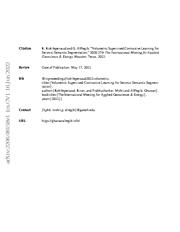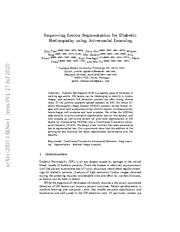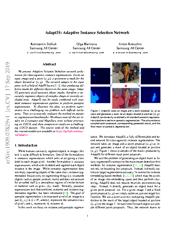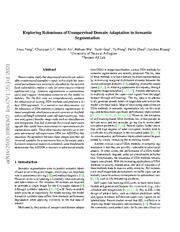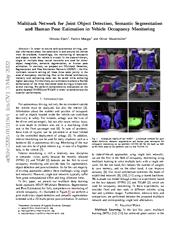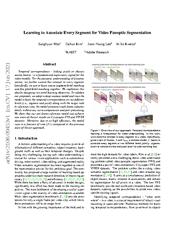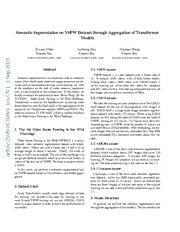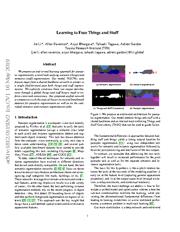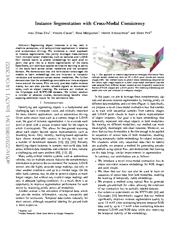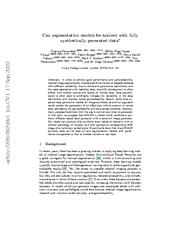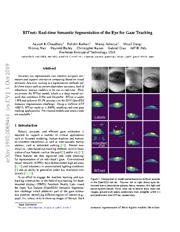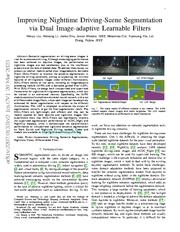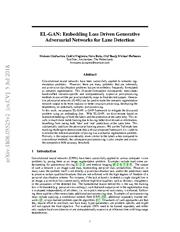A copy of this work was available on the public web and has been preserved in the Wayback Machine. The capture dates from 2019; you can also visit the original URL.
The file type is application/pdf.
Filters
Semi-Parametric Image Synthesis
2018
2018 IEEE/CVF Conference on Computer Vision and Pattern Recognition
Given a novel semantic layout at test time, the memory bank is used to retrieve photographic references that are provided as source material to a deep network. ...
The nonparametric component is a memory bank of image segments constructed from a training set of images. ...
Retrieval Given a novel semantic layout L at test time, we compute L mask j and L cont j for each semantic segment L j , by analogy with the definitions provided in Section 4.1. ...
doi:10.1109/cvpr.2018.00918
dblp:conf/cvpr/QiCJK18
fatcat:ymepyulqxrczloaqi7sp4st54e
Semi-parametric Image Synthesis
[article]
2018
arXiv
pre-print
Given a novel semantic layout at test time, the memory bank is used to retrieve photographic references that are provided as source material to a deep network. ...
The nonparametric component is a memory bank of image segments constructed from a training set of images. ...
Retrieval Given a novel semantic layout L at test time, we compute L mask j and L cont j for each semantic segment L j , by analogy with the definitions provided in Section 4.1. ...
arXiv:1804.10992v1
fatcat:ki4msx5gzbbjfowcugi37gz6wy
Volumetric Supervised Contrastive Learning for Seismic Semantic Segmentation
[article]
2022
arXiv
pre-print
We show that the learnt representations from our method out-perform a state of the art contrastive learning methodology in a semantic segmentation task. ...
In seismic interpretation, pixel-level labels of various rock structures can be time-consuming and expensive to obtain. ...
from this pre-training to fine-tune for the semantic segmentation task. ...
arXiv:2206.08158v1
fatcat:hsuzvfbmsnfu7mrthi67366wya
Improving Lesion Segmentation for Diabetic Retinopathy Using Adversarial Learning
[chapter]
2019
Lecture Notes in Computer Science
We utilize the HEDNet edge detector to solve a semantic segmentation task on this dataset, and then propose an end-to-end system for pixel-level segmentation of DR lesions by incorporating HEDNet into ...
We design a loss function that adds adversarial loss to segmentation loss. ...
In addition, we apply L-2 weight decay with a rate of 0.0005. The training and validation batch size is 4 and the testing batch size is 1. For all experiments, the model is trained for 5000 epochs. ...
doi:10.1007/978-3-030-27272-2_29
fatcat:beoj2vn4ancppmgwdarur73hvq
AdaptIS: Adaptive Instance Selection Network
[article]
2019
arXiv
pre-print
AdaptIS can be easily combined with standard semantic segmentation pipeline to perform panoptic segmentation. ...
The network adapts to the input point with a help of AdaIN layers, thus producing different masks for different objects on the same image. ...
Below we explain how we use the results of semantic segmentation at test time. Point proposal branch. ...
arXiv:1909.07829v1
fatcat:r5cqgy7upbbwrluftekeyfqeuu
Exploring Robustness of Unsupervised Domain Adaptation in Semantic Segmentation
[article]
2021
arXiv
pre-print
These observations motivate us to propose adversarial self-supervision UDA (or ASSUDA) that maximizes the agreement between clean images and their adversarial examples by a contrastive loss in the output ...
Such vulnerability makes it risky for some security-related applications (e.g., semantic segmentation in autonomous cars) and triggers tremendous concerns on the model reliability. ...
Specifically, we consider a clean image and its adversarial example as a positive pair and maximize agreement on their segmentation outputs by a contrastive loss. ...
arXiv:2105.10843v2
fatcat:hrr2myxiwnfczf4dh7zgjutvfe
Multitask Network for Joint Object Detection, Semantic Segmentation and Human Pose Estimation in Vehicle Occupancy Monitoring
[article]
2022
arXiv
pre-print
In the state-of-the-art, single or multiple deep neural networks are used for either object recognition, semantic segmentation, or human pose estimation. ...
In contrast, we propose our Multitask Detection, Segmentation and Pose Estimation Network (MDSP) -- the first multitask network solving all these three tasks jointly in the area of occupancy monitoring ...
A similar behavior is found for semantic segmentation with a loss of nearly 0.1 (mIoU) and human pose estimation with one of 0.15 (AP) points. ...
arXiv:2205.01515v1
fatcat:pjhn5cy7izaxdhqgv44l7ubfuu
Learning to Associate Every Segment for Video Panoptic Segmentation
[article]
2021
arXiv
pre-print
To validate our proposals, we adopt a deep siamese model and train the model to learn the temporal correspondence on two different levels (i.e., segment and pixel) along with the target task. ...
For the panoptic understanding of dynamic scenes, we further extend this concept to every segment. Specifically, we aim to learn coarse segment-level matching and fine pixel-level matching together. ...
(Right) The detailed illustration of the projection head, which is required for the contrastive learning at train time only. ...
arXiv:2106.09453v1
fatcat:k4abtl6lfzftjp7rlenssush5i
Semantic Segmentation on VSPW Dataset through Aggregation of Transformer Models
[article]
2021
arXiv
pre-print
Due to the emphasis on the task of video semantic segmentation, we participated in this competition. ...
Transformer is used as the backbone for extracting video frame features, and the final result is the aggregation of the output of two Transformer models, SWIN and VOLO. ...
Among these videos, 2806 videos with 198244 frames is set for training use, while other 343 videos for validation and 387 videos for test. ...
arXiv:2109.01316v1
fatcat:zyronmv6vjevnol4yo4ft27evm
Learning to Fuse Things and Stuff
[article]
2019
arXiv
pre-print
Our proposed unified network is competitive with the state of the art on several benchmarks for panoptic segmentation as well as on the individual semantic and instance segmentation tasks. ...
We propose an end-to-end learning approach for panoptic segmentation, a novel task unifying instance (things) and semantic (stuff) segmentation. ...
For test time augmentation, we conduct inference at multiple scales, each with a horizontal flip. ...
arXiv:1812.01192v2
fatcat:fyvj52qoorg3vntabha7qkoif4
Instance Segmentation with Cross-Modal Consistency
[article]
2022
arXiv
pre-print
We further conduct a number of ablation studies, demonstrating benefits when applying additional inputs for the contrastive loss. ...
Segmenting object instances is a key task in machine perception, with safety-critical applications in robotics and autonomous driving. ...
Sample outputs for our method over time can be found in Figure 5 . Semantic Segmentation: We predict a semantic mask for each frame and filter out all 'stuff' classes to a single background class. ...
arXiv:2210.08113v1
fatcat:la6nddx5ind6vk3pznbdpsraju
Can segmentation models be trained with fully synthetically generated data?
[article]
2022
arXiv
pre-print
Due to ethics and governance restrictions, and the costs associated with labelling data, scientific development is often stifled, with models trained and tested on limited data. ...
Experiments show that brainSPADE synthetic data can be used to train segmentation models with performance comparable to that of models trained on real data. ...
Our image generator provides the user with control over the content and contrast of the output images independently. ...
arXiv:2209.08256v1
fatcat:uxkiiygqxfa4fmxq5uselnm3xu
RITnet: Real-time Semantic Segmentation of the Eye for Gaze Tracking
[article]
2019
arXiv
pre-print
RITnet is under 1 MB and achieves 95.3% accuracy on the 2019 OpenEDS Semantic Segmentation challenge. ...
Using a GeForce GTX 1080 Ti, RITnet tracks at > 300Hz, enabling real-time gaze tracking applications. Pre-trained models and source code are available https://bitbucket.org/eye-ush/ritnet/. ...
We would also like to thank the Research Computing group at RIT for providing access to GPU clusters. ...
arXiv:1910.00694v1
fatcat:d736h34ugjdeznsunhbm2uxxtm
Improving Nighttime Driving-Scene Segmentation via Dual Image-adaptive Learnable Filters
[article]
2023
arXiv
pre-print
With DIAL-Filters, we design both unsupervised and supervised frameworks for nighttime driving-scene segmentation, which can be trained in an end-to-end manner. ...
Semantic segmentation on driving-scene images is vital for autonomous driving. ...
The whole pipeline is trained end-to-end with segmentation loss so that the CNN-PP is able to learn an appropriate DIF to enhance the image adaptively for better semantic segmentation. 2) Segmentation ...
arXiv:2207.01331v2
fatcat:aapwca7zvbgjzbs4peocn7yrki
EL-GAN: Embedding Loss Driven Generative Adversarial Networks for Lane Detection
[article]
2018
arXiv
pre-print
With EL-GAN, we discriminate based on learned embeddings of both the labels and the prediction at the same time. ...
We use the TuSimple lane marking challenge to demonstrate that with our proposed framework it is viable to overcome the inherent anomalies of posing it as a semantic segmentation problem. ...
Acknowledgments The authors would like to thank Nicolau Leal Werneck, Stefano Secondo, Jihong Ju, Yu Wang, Sindi Shkodrani and Bram Beernink for their contributions and valuable feedback. ...
arXiv:1806.05525v2
fatcat:6ckrbci3iredhly6o3z6ffooxm
« Previous
Showing results 1 — 15 out of 48,941 results



